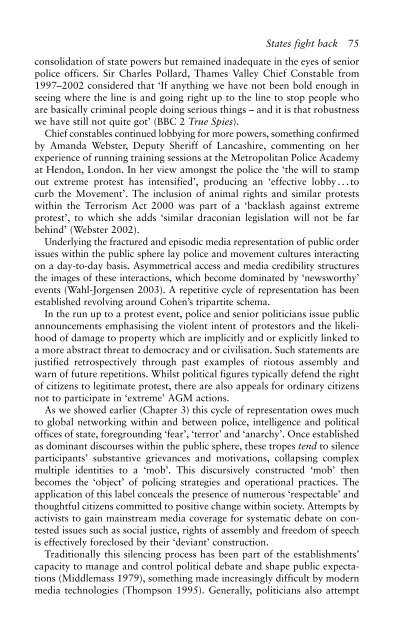Complexity and Social Movements: Multitudes at the Edge of Chaos ...
Complexity and Social Movements: Multitudes at the Edge of Chaos ...
Complexity and Social Movements: Multitudes at the Edge of Chaos ...
You also want an ePaper? Increase the reach of your titles
YUMPU automatically turns print PDFs into web optimized ePapers that Google loves.
St<strong>at</strong>es fight back 75<br />
consolid<strong>at</strong>ion <strong>of</strong> st<strong>at</strong>e powers but remained inadequ<strong>at</strong>e in <strong>the</strong> eyes <strong>of</strong> senior<br />
police <strong>of</strong>ficers. Sir Charles Pollard, Thames Valley Chief Constable from<br />
1997–2002 considered th<strong>at</strong> ‘If anything we have not been bold enough in<br />
seeing where <strong>the</strong> line is <strong>and</strong> going right up to <strong>the</strong> line to stop people who<br />
are basically criminal people doing serious things – <strong>and</strong> it is th<strong>at</strong> robustness<br />
we have still not quite got’ (BBC 2 True Spies).<br />
Chief constables continued lobbying for more powers, something confirmed<br />
by Am<strong>and</strong>a Webster, Deputy Sheriff <strong>of</strong> Lancashire, commenting on her<br />
experience <strong>of</strong> running training sessions <strong>at</strong> <strong>the</strong> Metropolitan Police Academy<br />
<strong>at</strong> Hendon, London. In her view amongst <strong>the</strong> police <strong>the</strong> ‘<strong>the</strong> will to stamp<br />
out extreme protest has intensified’, producing an ‘effective lobby ...to<br />
curb <strong>the</strong> Movement’. The inclusion <strong>of</strong> animal rights <strong>and</strong> similar protests<br />
within <strong>the</strong> Terrorism Act 2000 was part <strong>of</strong> a ‘backlash against extreme<br />
protest’, to which she adds ‘similar draconian legisl<strong>at</strong>ion will not be far<br />
behind’ (Webster 2002).<br />
Underlying <strong>the</strong> fractured <strong>and</strong> episodic media represent<strong>at</strong>ion <strong>of</strong> public order<br />
issues within <strong>the</strong> public sphere lay police <strong>and</strong> movement cultures interacting<br />
on a day-to-day basis. Asymmetrical access <strong>and</strong> media credibility structures<br />
<strong>the</strong> images <strong>of</strong> <strong>the</strong>se interactions, which become domin<strong>at</strong>ed by ‘newsworthy’<br />
events (Wahl-Jorgensen 2003). A repetitive cycle <strong>of</strong> represent<strong>at</strong>ion has been<br />
established revolving around Cohen’s tripartite schema.<br />
In <strong>the</strong> run up to a protest event, police <strong>and</strong> senior politicians issue public<br />
announcements emphasising <strong>the</strong> violent intent <strong>of</strong> protestors <strong>and</strong> <strong>the</strong> likelihood<br />
<strong>of</strong> damage to property which are implicitly <strong>and</strong> or explicitly linked to<br />
a more abstract thre<strong>at</strong> to democracy <strong>and</strong> or civilis<strong>at</strong>ion. Such st<strong>at</strong>ements are<br />
justified retrospectively through past examples <strong>of</strong> riotous assembly <strong>and</strong><br />
warn <strong>of</strong> future repetitions. Whilst political figures typically defend <strong>the</strong> right<br />
<strong>of</strong> citizens to legitim<strong>at</strong>e protest, <strong>the</strong>re are also appeals for ordinary citizens<br />
not to particip<strong>at</strong>e in ‘extreme’ AGM actions.<br />
As we showed earlier (Chapter 3) this cycle <strong>of</strong> represent<strong>at</strong>ion owes much<br />
to global networking within <strong>and</strong> between police, intelligence <strong>and</strong> political<br />
<strong>of</strong>fices <strong>of</strong> st<strong>at</strong>e, foregrounding ‘fear’, ‘terror’ <strong>and</strong> ‘anarchy’. Once established<br />
as dominant discourses within <strong>the</strong> public sphere, <strong>the</strong>se tropes tend to silence<br />
participants’ substantive grievances <strong>and</strong> motiv<strong>at</strong>ions, collapsing complex<br />
multiple identities to a ‘mob’. This discursively constructed ‘mob’ <strong>the</strong>n<br />
becomes <strong>the</strong> ‘object’ <strong>of</strong> policing str<strong>at</strong>egies <strong>and</strong> oper<strong>at</strong>ional practices. The<br />
applic<strong>at</strong>ion <strong>of</strong> this label conceals <strong>the</strong> presence <strong>of</strong> numerous ‘respectable’ <strong>and</strong><br />
thoughtful citizens committed to positive change within society. Attempts by<br />
activists to gain mainstream media coverage for system<strong>at</strong>ic deb<strong>at</strong>e on contested<br />
issues such as social justice, rights <strong>of</strong> assembly <strong>and</strong> freedom <strong>of</strong> speech<br />
is effectively foreclosed by <strong>the</strong>ir ‘deviant’ construction.<br />
Traditionally this silencing process has been part <strong>of</strong> <strong>the</strong> establishments’<br />
capacity to manage <strong>and</strong> control political deb<strong>at</strong>e <strong>and</strong> shape public expect<strong>at</strong>ions<br />
(Middlemass 1979), something made increasingly difficult by modern<br />
media technologies (Thompson 1995). Generally, politicians also <strong>at</strong>tempt




